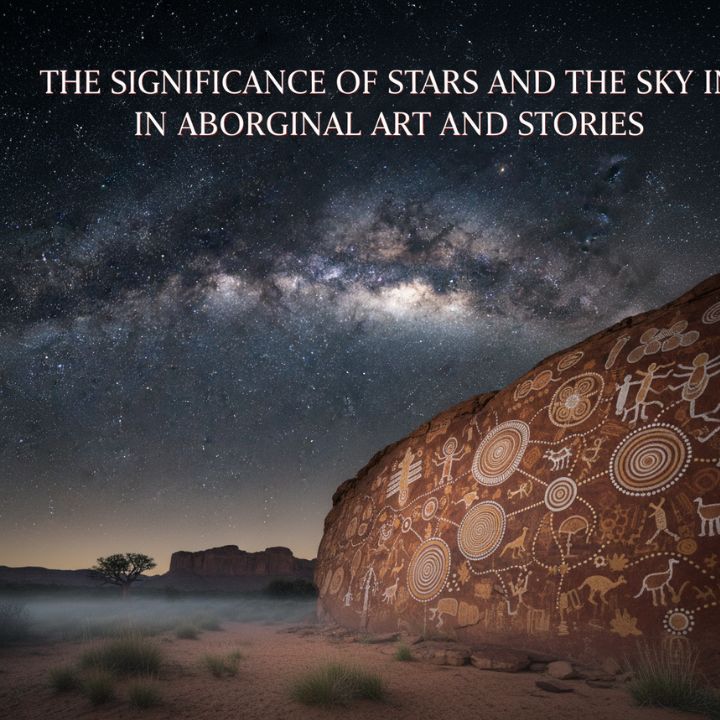
The Significance of Stars and the Sky in Aboriginal Art and Stories
Share
Thousands of years ago, the Aboriginal cultures were studying the night sky through the use of stars and constellations to interpret the stories, navigation, and cultural wisdom. The profound relationship of Aboriginal stars, Aboriginal sky narratives, and the Aboriginal night sky is a fertile aspect of the most ancient continuous culture of the world. We are privileged to display some of the artworks and Aboriginal art in Australia that manifest this rich relationship, showing that the celestial bodies are not merely sources of light, but also living elements of the Dreaming.
How the Aboriginal Night Sky Shapes Culture
To Aboriginal people, the night sky is much more than a backdrop of sky patterns- it is a dynamic map, a reliable calendar, and a living canvas of the ancestral narratives. This living document is used to direct everyday life, and it is a source of moral teachings, enlightening ceremonies, and retention of community knowledge through the generations. Through tracking the movements of stars native to the land, the elders could foresee the change of seasons, the quantity of food that could be available, the most appropriate moment to hold a ceremony, and socialise. These sky stories of the Aborigines are essential in comprehending the interrelationship between land, sky, and people in the Aboriginal world.
Aboriginal Constellations and Their Cultural Meanings
The Aboriginal constellations are very different from the Western ones, which mainly correlate the bright stars to create shapes. Most of the Aboriginal constellations or Aboriginal star constellations are dark constellations, constructions created by the dense dark dust lanes of the Milky Way. These heavenly cycles are so ingrained in Aboriginal Dreaming stories that they offer seasonal advice and important survival skills.
The Emu in the Sky
One of the most famous dark constellations is the Emu in the Sky. This Celestial Emu, which is observed in the dark areas of the Milky Way, seems to vary its location over the year. Its various positions in the Aboriginal night sky, in which it sits, runs and lays eggs, indicate various seasonal activities in the territory. The location of Emu in the Sky shows when it is time to gather emu eggs or to hunt the birds, a complex association between the universe and the earthly realm, with the Aboriginal communities. These Aboriginal night sky stories are vital to cultural lore and ceremonial importance.
Orion and the Pleiades (The Hunter and the Sisters)
The Australian version of the Orion and the Pleiades story is told throughout the country with variations depending on language group. In Australia, the Pleiades are known as the Seven Sisters and are a group of women who are hunted by Orion over the sky, which is commonly understood to be a hunter. Orion (Nyeeruna) in the traditions of the Yoinju people of Arnhem Land is a lustful hunter who constantly stalks the Sisters. The Western Desert version highlights the element of kinship and taboo relationships, with social regulations of the people whom they are not allowed to marry written in the story. Though the chase motive is widespread in all parts, moral teachings differ, depending on the cultural priorities in the place.
The Celestial Canoe
According to the Yoinju traditions of the Arnhem Land, the Southern Cross and Coalsack Nebula stars are a part of a canoe. Southern Cross has different meanings as well. Among the Yoinju groups, its part of a canoe along with the dark Coalsack Nebula, giving the representation of a fish or a passenger. In the adaptation, the canoe goes down the river of the Milky Way to direct navigation and song lines on land and sea. Conversely, to the Arrernte people of central Australia, the Southern Cross symbolises a wedge-tailed eagle, a strong creator spirit, who connects the constellation to tales of law and power. These differences show how the same stars are given different names based on the connection of the community to land and ancestry.
Scorpius and the Serpent
The stars of Scorpius are often associated with serpents, sometimes linked to the Rainbow Serpent, a creator being central to Dreamtime stories. In Arnhem Land, the curve of Scorpius is a large snake, and the movements of this snake define rivers and waterholes. To the Murrawarri people, the constellation means another type of serpent, which is linked to the tales of water and fertility. In both Scorpius, mirrors the religious responsibility of tending to water, but the focus of the story is different across the regions.
The Crow and the Eagle
In some regions, bright stars like Altair, Vega, and Deneb are linked to ancestral birds—the Crow (Waa) and the Eagle (Bunjil). These birds are powerful creator beings who established law and order. Their stellar forms serve as eternal reminders of their authority.
Other Stars and Constellations
Other bright stars, too, carry distinct cultural roles. The second brightest star in the night sky, Canopus, has become a seasonal indicator in most traditions, and it shows when some foods like eels or yams are in season. Some of the Victorian communities use Arcturus as a sign of the onset of winter, and bright stars such as Sirius and Vega are incorporated in sea navigation, which is necessary in travelling between the islands of the Torres Strait. These differences prove the flexibility of Aboriginal astronomy, when the same stars may be ecological signs in one part and also navigation signs.
How Aboriginal Art Represents the Stars and Sky
Aboriginal artists have long been translating their rich celestial knowledge into visual form. They represent the stars, constellations and tales of the sky by adopting various forms of media, such as dot paintings, bark paintings, and ceremonial art. The pictorial symbols of the art are not purely decorative, but mnemonics, in which ancient Aboriginal stars and the cultural stories that accompany them are maintained and transmitted.
Dot Painting Depictions of the Sky
In Central Australia, especially, the dot paintings are known to be very detailed in illustrating the night sky. Innumerable dots are utilised by the artists to depict Aboriginal star constellations, the Milky Way, and other objects in space. These paintings tend to depict the trails of the ancestral people as they travelled through the universe, and thus tie Dreaming stories with the astronomical events. The art is a living library of knowledge with the patterns and symbols capturing the complex Aboriginal star constellations and their heavenly symbolism.
Bark and Rock Art of Celestial Themes
Artists in Arnhem Land use the paintings as a means of capturing the Aboriginal night sky on the bark. They represent the figures of emus, lines of stars, and other patterns and save the Aboriginal sky narratives to posterity. On the same note, the ancient rock art on the continent has celestial themes, which demonstrate the eternal relationship between humans and the universe. These images act as a document of astronomical understanding and cultural stories, cut into the land and its resources.
Seasonal Knowledge and Navigation Using Stars
Aboriginal constellations and indigenous stars have been an advanced system of the calendar in Aboriginal communities for millennia. The appearance and disappearance of specific constellations are considered to predict the beginning of various seasons and the availability of specific sources of food. The stars also form part of the navigation system of the communities living along the coasts, who use them to direct their journey over expansive water bodies. This is a practical use of astronomical knowledge and indicates how scientifically and observationally well-informed he was.
Contemporary Aboriginal Art Inspired by the Sky
Contemporary Aboriginal artists still find the night sky to be their source of inspiration, re-telling ancient tales in a new way using new forms of media. The tradition is continued today through contemporary art, such as acrylic paintings, digital art and large-scale out-of-place installations. They emphasise the fact that Aboriginal stars and Aboriginal star constellations remain relevant and that such knowledge is not locked into the past, but rather an active aspect of contemporary life and art.
Respectful Ways to Engage With Aboriginal Sky Stories
When engaging with these profound Aboriginal night sky stories and the art they inspire, it is crucial to do so with respect. We advise readers to:
- Learn the stories: Seek out information from reputable sources and listen to Aboriginal voices.
- Support Aboriginal artists: Purchase authentic art from galleries like Mandel Aboriginal Art Gallery, which works directly with artists and respects cultural protocols.
- Respect cultural protocols: Understand that some knowledge is sacred and not for public sharing.
Conclusion: The Cultural Importance of Stars and Sky in Aboriginal Art
The Aboriginal stars, constellations and Aboriginal sky stories form a part of a rich tapestry of culture. They are not scientific curiosities but living objects which create identity, direct life, and even create wonder-working art. This knowledge system, developed and refined over thousands of generations, continues to shape our vision of the world and reminds us of the importance of preserving and honouring cultural heritage. If you’d like to know more or be part of this effort, feel free to contact us.
Experience Aboriginal Sky Stories at Mandel Aboriginal Art Gallery
We welcome you to come and see our gallery of sky-related pieces of art at the Mandel Aboriginal Art Gallery. Discover the stories of each piece, learn the history of indigenous art, about the importance of Aboriginal stars and the importance of Aboriginal constellations and make a part of this living ancient culture a part of your home by buying an original Aboriginal Art.
FAQ: Aboriginal Stars and Sky Stories
- What are Aboriginal constellations, and how do they differ from Western constellations?
The constellations of Aboriginal are not only the network built by linking the bright stars, but also the dark space between the bright stars, the dust lanes of the Milky Way. This is a big contrast to Western astronomy, which emphasises the sparkling points of light.
- What is the Emu in the Sky in Aboriginal culture?
The Emu in the Sky is a famous Aboriginal dark constellation. Its shape, formed by the dark dust clouds of the Milky Way, indicates seasonal changes. Its position in the sky tells Aboriginal communities when to collect emu eggs or when to hunt.
- How do Aboriginal night sky stories influence art?
Aboriginal artists use various media, including dot paintings, bark paintings, and rock art, to depict celestial themes. These artworks serve as visual representations of Aboriginal night sky stories, preserving cultural knowledge and connecting viewers to the narratives of the Dreaming.
- How do Aboriginal communities use stars for navigation and seasonal knowledge?
Aboriginal communities use the position of specific indigenous stars and constellations as a natural calendar to track seasons, predict weather patterns, and determine the availability of food and water. For groups in coastal areas, stars also provide a vital means of navigation.
- Where can I buy authentic Aboriginal art inspired by the sky?
You can buy authentic Aboriginal art from reputable galleries that work directly with artists and adhere to ethical protocols. The Mandel Aboriginal Art Gallery offers a curated collection of genuine artworks that celebrate the beauty and cultural significance of the stars and sky.

